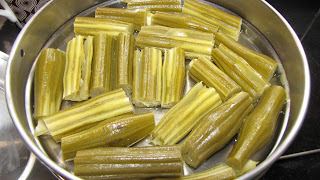Gooseberry
is one vegetable whose nutrient power stays intact in any form we take them:
fresh berries, pureed, cooked, sundried, pickled, powdered or whatever. It is
such a sought for item in Ayurveda; which is used in healing so many diseases and helps in leading
an immune, long & healthy life. Intensely rich in vitamin C, Amla does a
good fight against common cold and other such infections. Available almost through
the year, it is a common man’s inexpensive and natural remedy for hair &
skin care. Vitamin C is one nutrient that our body cannot store and use, so we
need to supply it every day; pickle is an easy way to achieve this because we
can store pickle and consume in small quantities regularly as it is not viable
to add fresh amla in everyday cooking.
Serves: NA
Preparation Time: 5
minutes
Cooking Time: 30 minutes
Ingredients:
1.
Gooseberry (Amla) – 1 kg
2.
Gingelly oil – 200ml
3.
Mustard seeds – 1 tbsp
4.
Asafoetida – ¼ tsp
5.
Turmeric powder – 1 tsp
6.
Chili powder – 3 tbsp
7.
Salt – 3 tbsp
8.
Jaggery – ½ tsp
9.
Fenugreek roasted and powdered – ¼ tsp
Method:
Step 1:
Wash, pat dry and steam cook the gooseberries whole to a soft texture. I do not
add water or salt to the berries while pressure cooking for 6-8 whistles. This is most of the cooking time; tempering the pickle takes around 10 minutes.
Step 2:
Once the pressure subsides and is cool enough, the berries can be taken out and
deseeded easily by hands as they already are almost split up into wedges.
Step 3:
Now heat Gingelly oil in a kadai and splutter mustard seeds in it, sprinkle
asafoetida and add the gooseberries.
Step 4:
Add salt, turmeric powder, chili powder, jaggery to it and mix well with light
hand so that the gooseberry wedges don’t get mashed up.
Step 5:
Once mixed well, taste and adjust spices; add fenugreek powder and mix well. It
is added at the end so that the aroma is arrested inside the pickle.
Step 6:
Save it in an airtight container and refrigerate for longer storage. Relish with curd
rice, parathas, khakhras and so on.
TIPS:
*After
cooking the gooseberries sometimes there is some amount of moisture let out by
the vegetable; this can either be used in the pickle or be used in a different
recipe such as gooseberry soup or so. I prefer not to use it in the pickle as moisture
reduces the shelf life of pickle.

























